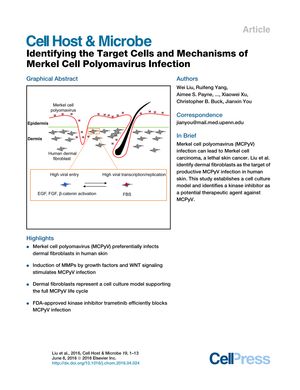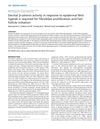Identifying the Target Cells and Mechanisms of Merkel Cell Polyomavirus Infection
May 2016
in “
Cell Host & Microbe
”
Merkel cell polyomavirus MCPyV Merkel cell carcinoma MCC human dermal fibroblasts EGF FGF GSK3 inhibitor CHIR99021 WNT/β-catenin signaling pathway MMP genes UV radiation trametinib MAP kinase pathway skin cancer epidermal growth factor fibroblast growth factor glycogen synthase kinase 3 inhibitor WNT signaling matrix metalloproteinase genes ultraviolet radiation Mekinist

TLDR Human dermal fibroblasts are the main cells targeted by a virus that can cause a deadly skin cancer, and a certain inhibitor can effectively block this infection.
The document from June 1, 2016, presents a study that identifies human dermal fibroblasts as the target cells for productive infection by Merkel cell polyomavirus (MCPyV), which can lead to Merkel cell carcinoma (MCC), a lethal form of skin cancer. The study found that the virus establishes replication factories within infected cells, with about 15,000 copies of the viral genome per cell detected by qPCR, and maintains infection for up to 20-30 days. The infection process is enhanced by factors such as EGF, FGF, and the GSK3 inhibitor CHIR99021, which activate the WNT/β-catenin signaling pathway and induce MMP genes, suggesting that skin damage from UV radiation and aging could increase susceptibility to MCPyV infection. The study also introduces trametinib as an effective inhibitor of MCPyV infection, indicating that the MAP kinase pathway may be required for MCPyV infection. These findings are significant for understanding the mechanisms of MCPyV infection and developing potential therapeutic strategies against MCPyV-associated MCC. The number of people or samples used in the study was not specified in the provided text.





